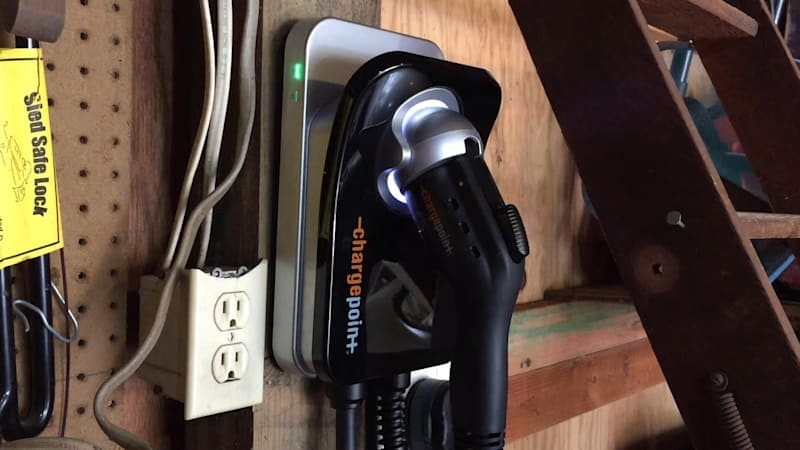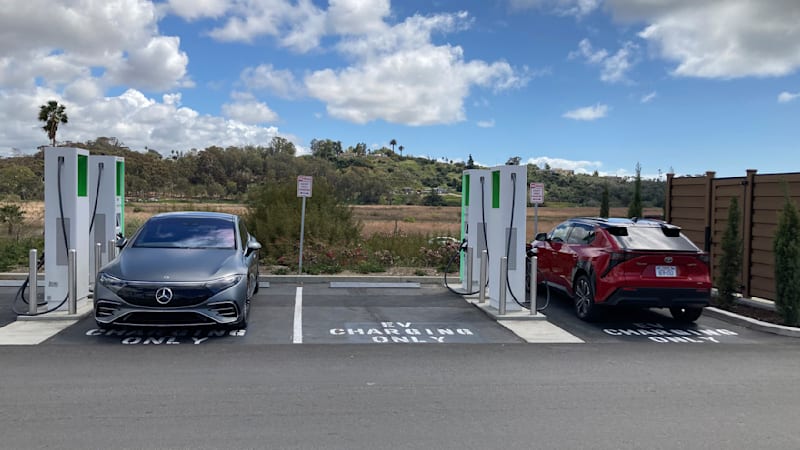What do Level 1, Level 2 and DC fast charging (Level 3) mean?

If you’re new to EVs, or are considering one, there’s a lot of unfamiliar terminology to learn. To most drivers, the biggest difference between an electric vehicle and one with a traditional gasoline engine is how you “fill up” the car.
With EVs, there are currently three ways to power up your batteries — conveniently called Level 1, Level 2 and DC fast charging (often referred to as “Level 3” or abbreviated as DCFC). It’s not necessary to worry about how many kilowatts the charger provides. A 200-kW charging station will work perfectly fine with an EV that charges at a maximum of 100 kW, and vice versa. While the differences between the levels revolve mostly around charging speed, asking, “How long does it take to go from empty to full?” is not necessarily the right question.
Read more: EV charging guide | What to know when buying an electric car
That’s because we’ve been conditioned on gasoline-powered cars to drive around until the needle points to empty, then pull into a gas station to top off the tank. With an EV, your primary “gas station” is often at your home. You can set off each morning with a full “tank” if you choose (though it’s not always recommended, and we’ll get to why below). For many drivers, there are only rare instances, like on long road trips, where charging speed becomes critical.
With that in mind, here are the differences between Level 1, Level 2 and DC fast charging, with explanations to help determine which one is best for you. Keep in mind that all of this also applies to plug-in hybrids as well as fully electric vehicles.
Level 1 charging
This is just a fancy way of referring to your standard wall outlet that most household appliances and electronics plug into. In the U.S., they emit 120 volts in alternating current (AC). Almost all electric cars will come with a wall connector cable, often referred to as a mobile charging cable, compatible with wall outlets.
This is also known as trickle charging because, well, it takes a while. Even if you leave your car plugged in overnight, you likely won’t have a full battery by morning. That’s because it’s usually limited to 10 or 12 amperes of current. It’s designed that way as to not overload the circuit box at your house, which is typically on 15- or 20-amp circuit breakers. Often, these circuit breakers are shared with lights and other household appliances, so it’s best to use a dedicated circuit.
Every car is different, but on most EVs, every hour of trickle charging gets you 2-5 miles. That means charging 12 hours from the time you get home from work to when you leave again the next day, you’re getting about 24-60 miles. That might be enough for your commute, especially if you don’t start from zero.

Level 2 charging
Level 2 charging uses 240 volts, either through a hardwired charger or via a 240V outlet that can usually be found in a typical house powering high-energy appliances like a clothes dryer. Level 2 chargers are also the most commonly available chargers found at public charging stations like office buildings and retail locations. All EVs come with Level 2 charging capability.
For home use, there are several types of 240V plug shapes, but the most common is called NEMA 14-50. Adapters are easily available as well, if you require them. These typically require a dedicated circuit of at least 50 amps, so you might need an electrician to set that up. Sometimes the mobile charging cable that comes with your car will have a 240V plug, and by using a 240V outlet, you won’t need a special wall unit or station at home.
Read more: Free EV charging perks for car buyers? Here’s what each automaker offers
If you charge at a public location, like at a shopping center or office, the chargers will have the plugs necessary for your EV. In addition, there are tens of thousands of public Level 2 chargers available around the country. Sometimes the businesses that host Level 2 chargers offer free charging, or they are operated by different companies such as EVgo or ChargePoint, and can be used for a fee.
The cost should work out to be less than what covering the same distance using gasoline would. In most EVs, Level 2 chargers will add 10 to 25 miles of range for each hour of charging. This is enough for an overnight charge to provide the typical owner with more than enough for a day’s worth of driving. Home charging at Level 2 is essentially like starting every morning with a full tank of gasoline, and how quickly it fills up rarely matters.

Level 3: DC fast charging
The fastest level of charging, DC fast charging (often referred to as Level 3, though that is a bit of a misnomer), is most similar to filling up at the pump. It’s the type of charging you use while on an extended road trip, pulling into a station every time the battery reads low.
There are three types on the market right now: CHAdeMO, Combined Charging System (CCS) and the Tesla Supercharger. These are usually located in areas along major interstate routes and urban areas. More are being added as EV ownership grows, as Starbucks and Volvo’s pilot program shows.
These use a 480V AC circuit, but convert the power to direct current (DC) before sending it to the vehicle. Since batteries use DC, this bypasses the car’s onboard charger that converts AC to DC, speeding up the process dramatically. Using one of these, a typical EV takes 15-45 minutes to reach 80% full.
As a caveat, some automakers say that repeated DCFC use will shorten the battery’s life, and have recommended not using DC fast charging on a daily basis. Research on this is not conclusive and is ongoing.
Why do electric car companies only provide figures for an 80% full charge?
Throughout the industry, charging time to 80% of the battery capacity is a norm. Think of charging with electricity like trying to fill a cup with a pitcher of water. As you get to the top, you have to slow down the rate of filling to avoid spilling. Similarly, DCFC rate slows significantly as you approach full in order to reduce the risk of overcharging the battery.
In addition, 80% is considered the sweet spot for optimal battery life. Leaving a battery plugged in and charging after it has reached at 100% can damage it over time. Regenerative braking also won’t be as strong when your battery is full. So, even if you park the car long enough to charge it to 100% overnight, it’s recommended that you set it to stop charging once it reaches 80% via the car’s or the charger’s software. That should still give you more than enough range for a daily routine, and on the day before a long road trip you can set it to charge to 100%.
Related video:



